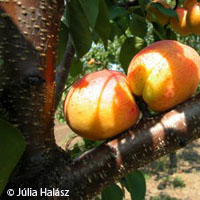Scientists find genetic link between Hungarian and Turkish apricots
People worldwide enjoy biting into a succulent, tasty apricot, but what do we know about the origins of this popular fruit? New research from Hungary and Turkey confirms what scientists have long suspected: there is a genetic link between Hungarian and Turkish apricot cultivars. The findings could provide apricot growers and breeders with new information on how to best select pollination partners in new orchard plantings. The study, the first to investigate the S-genotype diversity of apricots native to Turkey, was recently published in the Journal of the American Society for Horticultural Science. China has long been thought to be the original home of apricots, which later spread to Europe via Asia and Asia Minor. Experts classify apricot cultivars into four major eco-geographical groups: central Asian, Irano-Caucasian, European, and Dzhungar-Zailing. The most diverse groups are the central Asian group and the Irano-Caucasian group, which includes Turkish cultivars. The European group, which includes North American, South African and Australian cultivars, is the least diverse. Compared to other European apricots, eastern European cultivars have specific characteristics. Furthermore, despite the information they had on this fruit, in particular Turkish apricots, researchers were still uncertain about the self-incompatibility genotypes for several Turkish cultivars. Self-incompatibility refers to mechanisms used by plants to prevent self-fertilisation or fertilisation of a very closely related plant. In this study, researchers from Corvinus University of Budapest in Hungary plus Ataturk University and the Malatya Fruit Research Institute in Turkey performed microsatellite analyses showing that Hungarian and European apricot cultivars probably originated through hybridisation among Irano-Caucasian genotypes. They said historical and linguistic evidence seems to back this assumption. According to them, many records documented the introduction of Turkish graft-wood and other propagation materials to Hungary during the country's Ottoman occupation. Polymerase chain reaction (PCR) amplification was used by the team in order to establish the S-genotypes of a set of Turkish apricot cultivars. They also used the method to determine self-compatible apricot cultivars. 'We determined the complete S-genotype of 51 cultivars and the partial S-genotype of 4 cultivars,' explained Dr Júlia Halász from Corvinus University of Budapest, lead author of the study. 'A total of 32 different S-genotypes were assigned to the 51 cultivars, and many of them [28] were classified into newly established cross-incompatibility groups.' The researchers found that another 12 cultivars showed unique incompatible genotypes, and they identified 7 self-compatible cultivars in the examined collections. 'The fact that Turkish and Hungarian apricot cultivars carry 12 and 5 S-alleles, respectively, and all 5 alleles detected in Hungarian cultivars were also present in Turkish apricots furnished molecular evidence supporting the long-suspected historical connection between Hungarian and Turkish apricots,' Dr Halász said. 'The research confirms that Turkish germplasm contributed considerably to the development of several desirable Hungarian apricot cultivars.' She also pointed out that the relationship between the two gene pools is relatively new, linked with historical events that only go as far back as the early 18th century.For more information, please visit: Corvinus University of Budapest: http://www.uni-corvinus.hu/index.php?id=7745(opens in new window) Ataturk University: http://www.atauni.edu.tr/index_2.html(opens in new window) Journal of the American Society of Horticultural Science: http://journal.ashspublications.org/(opens in new window)
Countries
Hungary, Türkiye



